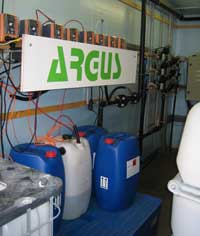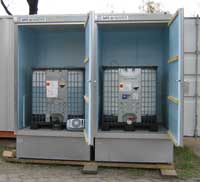


ARGUS Umweltbiotechnologie GmbH



© 2024 ARGUS Umweltbiotechnologie GmbH

Services
Case study_Biological In-Situ Remedation
Complex contamination of the groundwater aquifer, including BTEX, Chlorobenzene, Semi-Volatile Chlorinated Hydrocarbons (SVCH) and Organochloropesticides, was discovered within a subarea of a pharmaceutical company. Using infiltration of a nutrient solution, consisting of saltpeter, phosphoric acid and purified groundwater, offset with hydrogen peroxide, the existing microorganism population within the subsurface was then stimulated to assist in the breakdown of contaminants.
Infiltration was carried out continuously through 6 groundwater wells with varying dimensions, with injection rates of 0.4 - 1.5 m³/h per well using a redundantly covered, fully automatic, SPS-controlled, remotely-monitored dosing station. The usage of strong acids and bases required high specifications for work protection and the applied materials.
Over the 2 years of operation, a total of 73 000 m³ of nutrient solution was infiltrated, including 16 t saltpeter, 10 t phosphoric acid and 53 t hydrogen peroxide. A comprehensive monitoring program provided data for the regulation of nutrient-dosage.
In this time, contaminant concentrations in the most-highly impacted well sank, as illustrated in the following table.
Infiltration was carried out continuously through 6 groundwater wells with varying dimensions, with injection rates of 0.4 - 1.5 m³/h per well using a redundantly covered, fully automatic, SPS-controlled, remotely-monitored dosing station. The usage of strong acids and bases required high specifications for work protection and the applied materials.
Over the 2 years of operation, a total of 73 000 m³ of nutrient solution was infiltrated, including 16 t saltpeter, 10 t phosphoric acid and 53 t hydrogen peroxide. A comprehensive monitoring program provided data for the regulation of nutrient-dosage.
In this time, contaminant concentrations in the most-highly impacted well sank, as illustrated in the following table.
Contaminant Concentrations:
Microbiological saturation of the soil zone was disqualified as a result of subsequent investigations.
Dosing stations with redundant pump systems
Depot for acids and leaches
59
88
213
Organochloropesticides
48
452
868
SVCH
94
311
4.976
Monochlorobenzene
94
555
8.775
BTEX
Contaminat
Beginning of Treatment
in µg/l
in µg/l
After 2 Years
in µg/l
in µg/l
Remediation Performance
in %
in %



